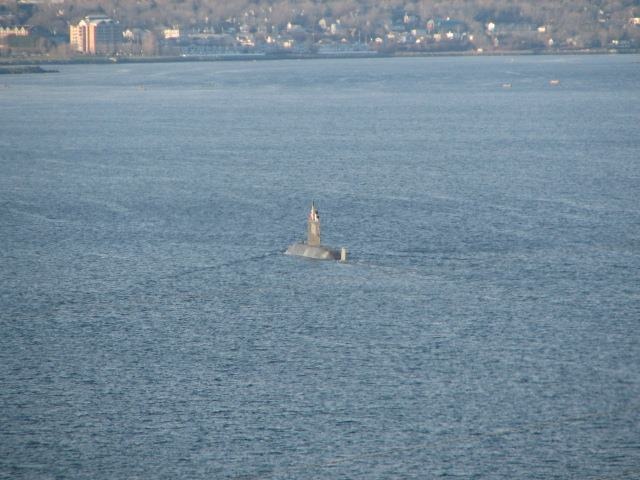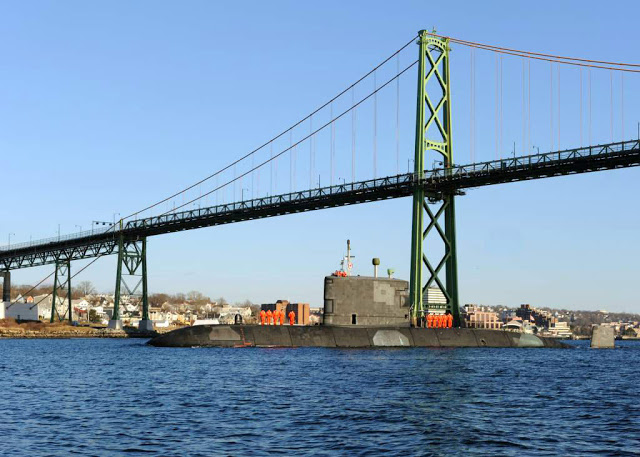With 21 foot seas reported in the approaches, the pilot boats are staying put. Pilotage ops are suspended,with updates every 2 hours. As a result Atlantic Cartier, and Kiel Express are paceing outside the harbour, and the car carrier Don Juan is staying put at autoport, despite being scheduled to leave yesterday evening. OOCL California is also ready to depart when weather improves.
Yearly Archives: 2012
Royal Nova Scotia Yacht Squadron to host 2013 Disabled Sailing Event
Information about the 2013 Mobility Cup can be found at www.MobilityCup1013.ca
Sloman Hera
Pegasus
Work Continues on Dorothea
work continues on the NS Sea Schools Dorothea. More ribs were installed today.
Find out more about the Sea School at seaschool.org or condier supporting them here
HMCS Toronto, out of Nova Dock
Windsor on trials in Basin
HMCS Windsor was spotted on trials in the basin this afternoon.
Photo from a reader via the Facebook page
DND Press release:
HMCS Windsor Returns to Sea
NR – 12.022 – December 14, 2012
OTTAWA – Her Majesty’s Canadian Submarine (HMCS) Windsor returned to sea yesterday at Halifax, N.S., officially marking the completion of a deep maintenance cycle known as an Extended Docking Work Period.
“HMCS Windsor’s return to sea is a key milestone and her crew now embarks on another challenging journey as they focus on operations at sea,” said The Honourable Peter MacKay, Minister of National Defence. “I commend the outstanding efforts of Windsor’s crew, our Fleet Maintenance Facilities and of industry that have brought us to this point.”
“Over the next few months, Windsor will conduct additional crew training and trials on her path to high readiness,” said Vice-Admiral Paul Maddison, Commander Royal Canadian Navy. “This milestone builds on the achievements of HMCS Victoria and is another important step towards the Victoria-class Submarine Fleet achieving steady state.”
With the completion of the Extended Docking Work Period, HMCS Windsor will now conduct a series of sea trials, crew training and certifications to prepare for future operations, a process known as the Tiered Readiness Program. HMCS Windsor’s Tiered Readiness Program will closely resemble the one conducted by HMCS Victoria, the first Victoria-class Submarine to become operational and weapons certified to fire MK 48 Heavyweight Torpedoes.
The Victoria-class Submarine Fleet continues to progress towards steady state when three of four submarines will be available for operations. This will include a high readiness submarine available on both the Atlantic and Pacific coasts, HMCS Windsor and HMCS Victoria respectively, with a third submarine, HMCS Chicoutimi, available at standard readiness. HMCS Corner Brook will rotate into an Extended Docking Work Period in 2013. An Extended Docking Work Period provides the submarines’ 200-plus systems with the maintenance and upgrades needed to conduct operations on behalf of Canadians.
DND Photo
See http://www.forces.gc.ca/site/news-nouvelles/news-nouvelles-eng.asp?id=3979 for the current status of all 4 submarines.
CCGS Corporal Teather C.V. Launch on the 15th
Reports are that the launch of CCGS Corporal Teather C.V., the third hero Class Mid Shore Patrol Vessel, will happen the morning of Saturday, Dec 15.
Updates (and a more recent photo) to Follow.
Everything Old Is new Again NOVIA for Melfi
Whats the building floating in the Basin? – The DRDC Barge
Ever wonder what the Floating Shed in the bedford Basin Is?
From BIO:
The DRDC Atlantic Acoustic Calibration Barge is located in Bedford Basin, about 5 km by water from DRDC Atlantic. The main function of the Barge is to conduct acoustic calibrations of sonar transducers such as hydrophones and projectors, in a free field salt water environment. It is also used to test and evaluate many other types of sea-going scientific apparatus and military equipment. The chief customers are DRDC Atlantic defence scientists, the Canadian Forces, other government departments and Canadian industry. It is equipped like a combined floating laboratory and workshop. The 300 tonne barge is 36 metres long by 17 metres wide. The main working area is covered by an enclosed heated deckhouse 30 metres by 13 metres, which allows calibrations to be performed year round. The hull contains a rectangular well 18 metres by 9 metres through which equipment under test can be lowered into the water. The barge is moored 1 kilometre from the nearest shore in a water depth of 42 metres. A 10 tonne crane is fitted to the outside deck for unloading equipment and a 5 tonne travelling crane is used to position apparatus over the well. Rotating stations with capacities up to 7 tonnes are available to position sonar transducers at any required orientation and depth.
CFAV Quest also takes part in this reasearch. from DRDC:
the research, development and testing of the systems needed by the Canadian Navy to maintain a state of readiness for maritime warfare often requires that the laboratory be transported to the field so that the work can be performed under “real world” conditions.
To this end, Defence R&D Canada — Atlantic (DRDC Atlantic) employs the Canadian Forces Auxiliary Vessel Quest. Maintained by the Navy and manned by Maritime Forces Atlantic Auxiliary seamen, Quest conducts 7 to 10 trials per year, spending up to 160 days at sea.
These trials encompass a wide range of R&D activity, from research on the acoustic properties of the ocean to experiments on ship signatures and safety. As well, the evaluation of prototype acoustic detection systems is often the first step in the process leading to procurement of new systems for the Navy.
This broad range of R&D activities requires a capable and versatile vessel; thus, Quest was designed with spacious laboratories, large working deck areas, and very capable marine cranes and specialized equipment handling systems.
The vessel was designed with a large margin of stability and this, combined with its roll–stabilization system and constant displacement systems, makes Quest a safe and stable platform from which to carry out experiments, even in heavy seas.
Of particular note are the acoustic quieting features of the vessel, which reduce the ship’s radiated noise to virtually undetectable levels when the vessel is configured in its “quiet state”.
Quest has conducted research in support of other government departments, universities and Canadian industry, where joint research is mutually beneficial. Quest has participated in Canadian and NATO naval exercises requiring the operational evaluation of prototype equipment.





